LYONS, Ore. — The Beachie Creek Fire burned nearly 200,000 acres in 2020. The devastating fire tore through the Santiam Canyon. Five people died and homes and businesses burned. About 16,000 acres in the Santiam State Forest also burned along with millions of trees. But now there are big efforts to restore the landscape and replant trees.
A crew of 12 people covered a lot of ground Thursday as they planted about 120 trees an hour, or roughly two trees a minute.
“Each person plants about 900 trees a day. So they can plant, you know, 10,000 to 12,000 trees a day,” said John Walter with the Oregon Department of Forestry (ODF). He said each person plants about two and a half acres each day.
Walter said the agency has contracted with three 12-person crews to plant trees in heavily burned areas of the Santiam State Forest from December through March.
“We did some planting after the fires last year. This year we're going to be planting a million trees on state forests,” said Walter.
He said in addition to people on the ground planting and spacing trees, ODF has also scattered seeds from the air to try and replenish the trees lost in the Beachie Creek Fire.
“If we didn't replant, this area might not have any trees for 10 years before seed landed here from the trees that were left,” Walter said.
He said the areas that have been targeted for replanting are in spots that were highly impacted by the fire and don’t have a good natural seed source.
Jason Cox, spokesperson for the Oregon Department of Forestry, said it may take 40-80 years for the replanted, burned forest to reach a state similar to what it was before the fire. Without the active efforts to replant, Cox said it would take even longer for the fire-impacted forests to come back.
Despite the long timeline, he said efforts to replant trees are important for a number of reasons.
“One, is providing a place for Oregonians to get out and enjoy nature and another is generating revenues predominantly through the sale of timber to both fund the state forest program and to provide revenue to local communities, school districts, that sort of thing,” said Cox.
He said in addition, reforesting also reduces soil erosion and runoff into streams, resulting in cleaner water.
According to Cox, ODF chose a mix of native species that are likely to do well in the area and hold up against fire and disease. Types of trees include Douglas fir, noble fir, alder, western redcedar and hemlock.
In a typical year, ODF plants about 200,000-250,000 trees in the Santiam State Forest. But over the course of several years, Walter said the agency will plant a total of 4 million trees for the wildfire replanting project.
Half of them are coming from a roughly $1 million grant from the nonprofit, American Forests. ODF officials said the donation is a big help. While most of the Santiam State Forest is back open, Cox said the scope of the damage in the burned areas is so great, it's hard to budget for, especially considering all the money needed to restore other things like recreation sites, roads and ensuring public safety on forest land.
Cox said ODF expects to be done replanting in burned areas by spring of 2024.

